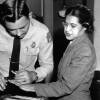In 2010, a pregnant Nathalia Holt and her husband were facing a common problem among parents.
“We were just having a really difficult time coming up with names,” she says. And when her husband suggested Eleanor Francis, Holt did what modern parents do. “I googled the name.”
Holt stumbled across a photo of a woman, Eleanor Francis Helin, accepting an award at NASA in 1966. Holt was “stunned by the picture.” She hadn’t realized women worked at NASA in the ‘60s. And the more she learned, the more surprised she became.
In 1942, NASA promoted a woman named Macie Roberts to be a supervisor in the Jet Propulsion Lab (JPL) in California. Roberts took her new role to heart, and made a decision to hire only women. Many of Roberts’ hires went on to have immense roles in the field of rocketry and long careers at NASA.
The women — originally hired as mathematicians — calculated rocket trajectories, studied the effects of different propellants, and laid the foundation for the first American satellite.
But it was the arrival of computers that put even more cracks in the glass ceiling.
Many at NASA initially did not trust the new, digital interlopers. Early computers were plagued by unreliability, breakdowns, and overheating. They were passed off to the women, who became responsible for them.
IBM offered computer-training courses, and women frequently enrolled. Armed with expertise, they then became some of the first computer programmers in the lab.
But until Holt’s book, Rise of the Rocket Girls: The Women Who Propelled Us, from Missiles to the Moon to Mars, JPL’s rich tradition of female rocket scientists was largely forgotten.
In 2008, NASA held a gala to celebrate the 50th anniversary of Explorer 1. But they neglected to invite the women who worked on the satellite, including the women who had literally been in mission control at the time of the launch.
“They’ve just been forgotten,” says Holt. “There are so many cases of this, of women who have been critical to research, who have had amazing discoveries, and who haven’t been recognized. And I think it’s important that we find their stories and recognize their contributions.”




